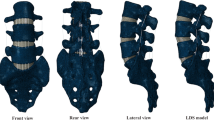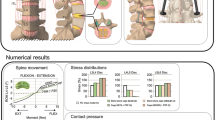Abstract
Facetectomy and laminectomy are techniques for decompressing lumbosacral spinal stenosis. Resections of posterior bony or ligamentous parts normally lead to a decrease in stability. The degree of instability depends on the extent of resection, the loading situation and the condition of the intervertebral discs. The correlation between these parameters is not well understood. In order to investigate how these parameters relate to one another, a three-dimensional, non-linear finite element model of the lumbosacral spine was created. Intersegmental rotations, intradiscal pressures, stresses, strains and forces in the facet joints were calculated while simulating an intact spine as well as different extents of resection (left and bilateral hemifacetectomy, hemilaminectomy and bilateral laminectomy, two-level laminectomy), disc conditions (intact and degenerated) and loading situations (pure moment loads, standing and forward bending). The results of the modelling showed that a unilateral hemifacetectomy increases intersegmental rotation for the loading situation of axial rotation. Expanding the resection to bilateral hemifacetectomy increases intersegmental rotation even more, while further resection up to a bilateral laminectomy has only a minor additional effect. Hemilaminectomy and laminectomy only differ in their effect for ventriflexion and muscle-supported forward bending. Two-level laminectomy increases the intersegmental rotation only for standing. Degenerated discs result in smaller intersegmental rotations and higher disc stresses at the respective levels. Decompression procedures affect the examined biomechanical parameters less markedly in degenerated than in intact discs. Resection of posterior bony or ligamentous elements has a stronger influence on the amount than on the distribution of stresses and deformations in a disc. It has only a minor effect on the biomechanical behaviour of the adjacent region. Spinal stability is decreased after a laminectomy for forward bending, and after a two-level laminectomy for standing. For axial rotation, spinal stability is decreased even after a hemifacetectomy. Patients should therefore avoid excessive axial rotation after such a treatment.







Similar content being viewed by others
References
Abumi K, Panjabi MM, Kramer KM, Duranceau J, Oxland T, Crisco JJ (1990) Biomechanical evaluation of lumbar spinal stability after graded facetectomies. Spine 15:1142–1147
Adams MA, Bogduk N, Burton K, Dolan P (2002) The biomechanics of back pain. Churchill Livingstone, Edinburgh London New York
Atlas SJ, Keller RB, Robson D, Deyo RA, Singer DE (2000) Surgical and nonsurgical management of lumbar spinal stenosis: four-year outcomes from the Maine lumbar spine study. Spine 25:556–562
Benz RJ, Garfin SR (2001) Current techniques of decompression of the lumbar spine. Clin Orthop 384:75–81
Bogduk N, Macintosh JE, Pearcy MJ (1992) A universal model of the lumbar back muscles in the upright position. Spine 17:897–913
Calisse J, Rohlmann A, Bergmann G (1999) Estimation of trunk muscle forces using the finite element method and in vivo loads measured by telemeterized internal spinal fixation devices. J Biomech 32:727–731
Goel VK, Kong W, Han JS, Weinstein JN, Gilbertson LG (1993) A combined finite element and optimization investigation of lumbar spine mechanics with and without muscles. Spine 18:1531–1541
Goel VK, Monroe BT, Gilbertson LG, Brinckmann P (1995) Interlaminar shear stresses and laminae separation in a disc. Finite element analysis of the L3-L4 motion segment subjected to axial compressive loads. Spine 20:689–698
Goel VK, Ramirez SA, Kong W, Gilbertson LG (1995) Cancellous bone Young's modulus variation within the vertebral body of a ligamentous lumbar spine--application of bone adaptive remodeling concepts. J Biomech Eng 117:266–271
Kato Y, Panjabi MM, Nibu K (1998) Biomechanical study of lumbar spinal stability after osteoplastic laminectomy. J Spinal Disord 11:146–150
Lavaste F, Skalli W, Robin S, Roy-Camille R, Mazel C (1992) Three-dimensional geometrical and mechanical modelling of the lumbar spine. J Biomech 25:1153–1164
Natarajan RN, Andersson GB, Patwardhan AG, Andriacchi TP (1999) Study on effect of graded facetectomy on change in lumbar motion segment torsional flexibility using three-dimensional continuum contact representation for facet joints. J Biomech Eng 121:215–221
Niggemeyer O, Strauss JM, Schulitz KP (1997) Comparison of surgical procedures for degenerative lumbar spinal stenosis: a meta-analysis of the literature from 1975 to 1995. Eur Spine J 6:423–429
Panjabi MM, Oxland T, Takata K, Goel V, Duranceau J, Krag M (1993) Articular facets of the human spine. Quantitative three-dimensional anatomy. Spine 18:1298–1310
Patwardhan AG, Havey RM, Meade KP, Lee B, Dunlap B (1999) A follower load increases the load-carrying capacity of the lumbar spine in compression. Spine 24:1003–1009
Quint U, Wilke HJ, Loer F, Claes LE (1998) Funktionelle Folgen operativer Dekompression am lumbalen Bewegungssegment—eine biomechanische Studie in vitro. Z Orthop Ihre Grenzgeb 136:350–357
Rohlmann A, Neller S, Bergmann G, Graichen F, Claes L, Wilke H-J (2001) Effect of an internal fixator and a bone graft on intersegmental spinal motion and intradiscal pressure in the adjacent regions. Eur Spine J 10:301–308
Rohlmann A, Neller S, Claes L, Bergmann G, Wilke H-J (2001) Influence of a follower load on intradiscal pressure and intersegmental rotation of the lumbar spine. Spine 26:E557–E561
Shirazi-Adl A (1991) Finite-element evaluation of contact loads on facets of an L2-L3 lumbar segment in complex loads. Spine 16:533–541
Shirazi-Adl A, Ahmed AM, Shrivastava SC (1986) Mechanical response of a lumbar motion segment in axial torque alone and combined with compression. Spine 11:914–927
Smit T (1996) The mechanical significance of the trabecular bone architecture in a human vertebra. Shaker, Aachen
Turner JA, Ersek M, Herron L, Deyo R (1992) Surgery for lumbar spinal stenosis. Attempted meta-analysis of the literature. Spine 17:1–8
Wilke HJ, Neef P, Caimi M, Hoogland T, Claes LE (1999) New in vivo measurements of pressures in the intervertebral disc in daily life. Spine 24:755–762
Wilke H, Neef P, Hinz B, Seidel H, Claes L (2001) Intradiscal pressure together with anthropometric data—a data set for the validation of models. Clin Biomech 16:S111–S126
Zander T, Rohlmann A, Calisse J, Bergmann G (2001) Estimation of muscle forces in the lumbar spine during upper-body inclination. Clin Biomech 16:S73–S80
Zander T, Rohlmann A, Klöckner C, Bergmann G (2002) Influence of bone graft characteristics on mechanical behaviour of the spine. J Biomech 35:491–497
Acknowledgements
The original element mesh of the L4 vertebra was created by Smit. It is available on the Internet at the ISB Finite Element Repository managed by the Instituti Ortopedici Rizzoli. Finite element analyses were performed at the Konrad-Zuse-Zentrum für Informationstechnik Berlin (ZIB) and Zentraleinrichtung Rechenzentrum Berlin (ZRZ). The authors thank Dr. J. Weirowski for editorial assistance. Funding for this study was obtained from the Deutsche Forschungsgemeinschaft, Bonn, Germany (Ro 581/13–2).
Author information
Authors and Affiliations
Corresponding author
Rights and permissions
About this article
Cite this article
Zander, T., Rohlmann, A., Klöckner, C. et al. Influence of graded facetectomy and laminectomy on spinal biomechanics. Eur Spine J 12, 427–434 (2003). https://doi.org/10.1007/s00586-003-0540-0
Received:
Revised:
Accepted:
Published:
Issue Date:
DOI: https://doi.org/10.1007/s00586-003-0540-0




